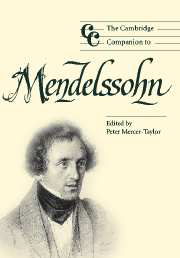Book contents
- Frontmatter
- Introduction: Mendelssohn as border-dweller
- Part I Issues in biography
- Part II Situating the compositions
- Part III Profiles of the music
- 6 Symphony and overture
- 7 The works for solo instrument(s) and orchestra
- 8 Mendelssohn's chamber music
- 9 The music for keyboard
- 10 On Mendelssohn's sacred music, real and imaginary
- 11 Mendelssohn's songs
- 12 Felix Mendelssohn's dramatic compositions: from Liederspiel to Lorelei
- Part IV Reception and performance
- Notes
- Select bibliography
- Index
7 - The works for solo instrument(s) and orchestra
from Part III - Profiles of the music
Published online by Cambridge University Press: 28 September 2011
- Frontmatter
- Introduction: Mendelssohn as border-dweller
- Part I Issues in biography
- Part II Situating the compositions
- Part III Profiles of the music
- 6 Symphony and overture
- 7 The works for solo instrument(s) and orchestra
- 8 Mendelssohn's chamber music
- 9 The music for keyboard
- 10 On Mendelssohn's sacred music, real and imaginary
- 11 Mendelssohn's songs
- 12 Felix Mendelssohn's dramatic compositions: from Liederspiel to Lorelei
- Part IV Reception and performance
- Notes
- Select bibliography
- Index
Summary
Sir Donald Francis Tovey declared,
The best works of Mendelssohn have all in their respective ways been the starting-points of some musical revolution. Mendelssohn may truthfully be said to have destroyed the classical concerto.
Felix Mendelssohn Bartholdy completed eleven works in the genre of solo instrument(s) and orchestra. Spanning more than two decades, they range from the thirteen-year-old's little-known Concerto for Piano and Strings in A minor, composed in 1822, to one of Mendelssohn's most popular works, the Concerto for Violin and Orchestra in E minor op. 64 (1845). Examined together as a group, they reveal a fascinating trajectory, manifesting a terrific growth in imagination and inventiveness. These works run the gamut from rather insecure and uneven student pieces to a great, confident masterpiece, through light-hearted, quickly dashed off virtuosic showpieces, to deeply introspective, rarified musical statements.
In only one other specific genre, that of the string quartet, did the composer work as consistently throughout his life as he did at the compositions of concertos. And this was not an easy task. As R. Larry Todd notes,
throughout his career, Mendelssohn found the writing of concertos an especially arduous task and confessed to friends his struggle to reconcile the competing demands of virtuosity and the integrity of the compositions as works of art.
- Type
- Chapter
- Information
- The Cambridge Companion to Mendelssohn , pp. 112 - 129Publisher: Cambridge University PressPrint publication year: 2004

